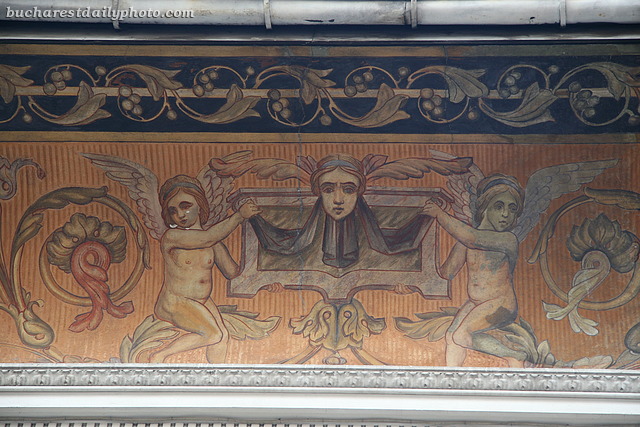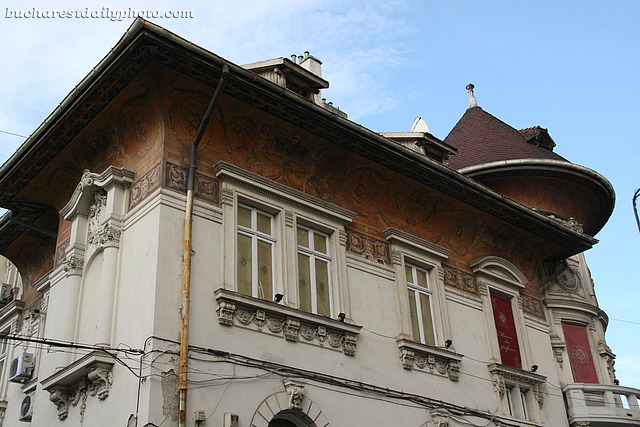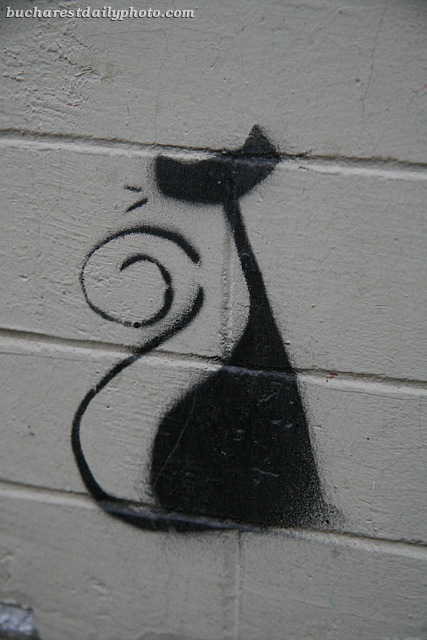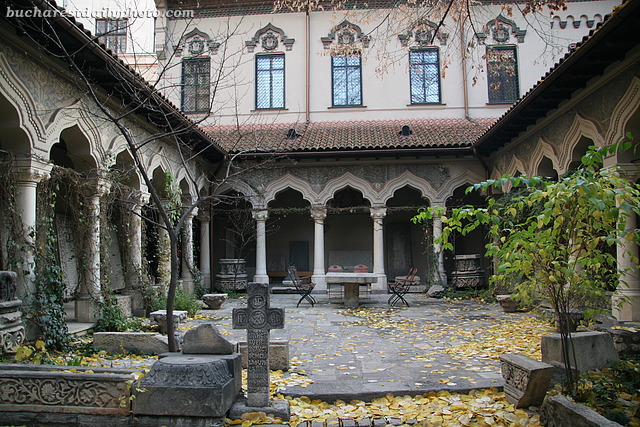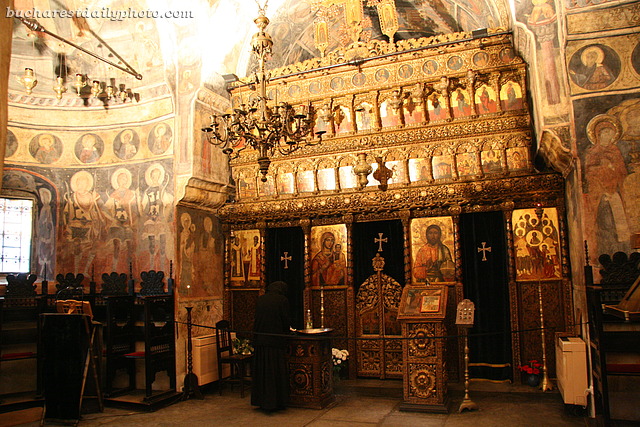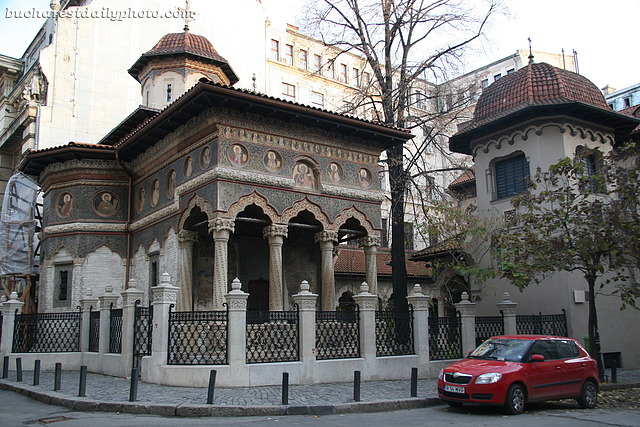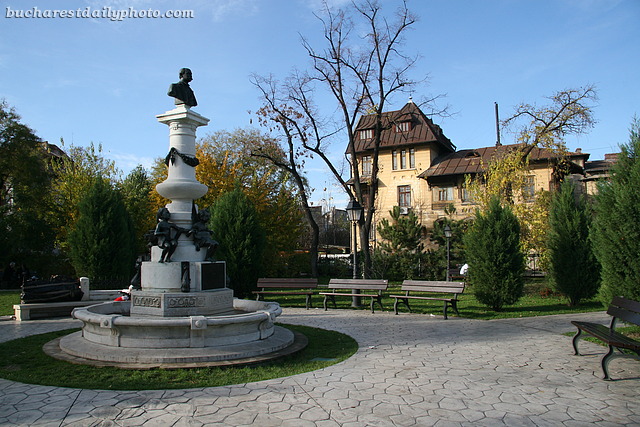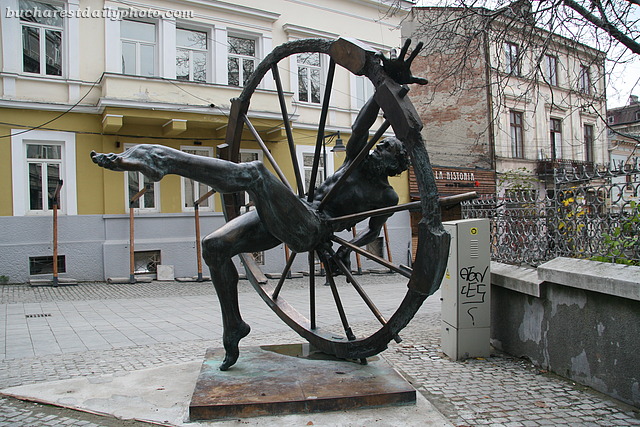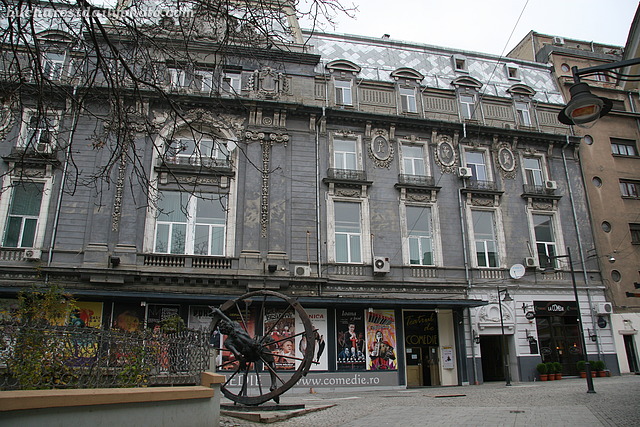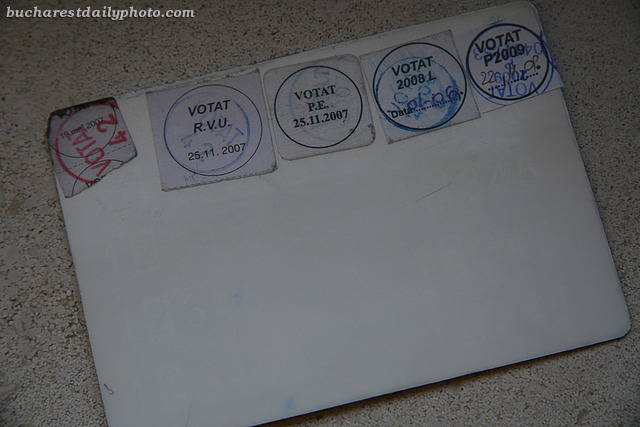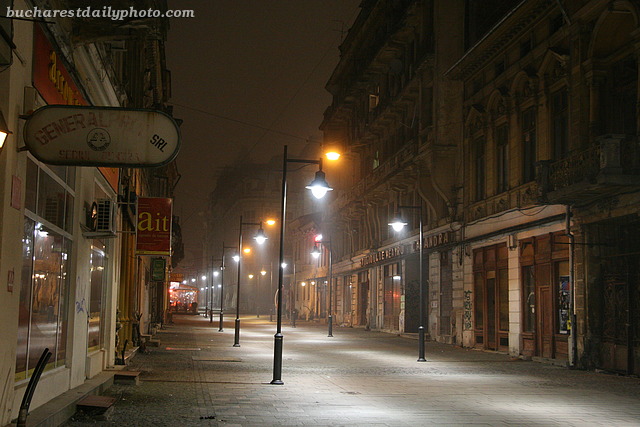Today’s photo shows a close-up of an outside mural that belongs to a beautiful house I spotted on one of my Sunday strolls. According to one source I found on the web (in Romanian), painting murals on the outside of houses was a fashion imported from Italy, present in Bucharest between the years 1905-1915. The house is on Take Ionescu Street, close to Lahovari Square.
After talking about serious subjects for the last few days I thought that it’s time for something lighter: a cute stencil graffiti I found in the Old Town.
Alongside the church there is a small beautiful yard surrounded by a porticoes on three sides. This building has been added during the restoration done in 1899-1901 by architect Ion Mincu and if you look closely you’ll notice that the porticoes are inspired by the architecture of the church. This building shelters a library with a collection of old manuscripts, a refectory where conferences are held, and a collection of 18th century religious objects, some of them brought here from other churches and monasteries that were demolished in the communist years. The convent’s caretakers also work to restore old books, icons, other liturgical objects and clothes, to translate old books and to transcribe old musical scores digitally. The church is also famous for its choir which sings Byzantine music. I really like the courtyard with its old tombstones and fragments of old sculptures. I’ve seen it in many types of weather, on a sunny morning or under grey skies, when it was snowing or when it was raining and it always looks beautiful and has a peaceful and quiet feel.
In yesterday’s post I was saying that I believe it’s impossible to visit Stavropoleos and not be moved in some way. This feeling will be even stronger at the sight of the church interior. You’ll find the same fresco-covered walls and golden iconostasis found in most Eastern Orthodox churches but somehow they look more exceptional here. If you are Christian you’ll feel like the church interior encourages prayer and meditation. Even the tourists leave their cameras aside and sit quiet on the little benches. The black silhouette that you see in the photo is of one of the nun caretakers who was tending the candles.
This charming little church is one of the oldest in Bucharest. It was built between the years 1724 to 1730 during the ruling of Nicolae Mavrocordat (Prince of Wallachia 1719-1730) by the Greek monk Ioanichie Stratonikeas. Although tiny, every little detail is worth looking at: the richly adorned columns of the porch, the exterior paintings and carvings, the frescoes of the interior and the golden altar. I think it’s impossible to visit churches like Stavropoleos and not be moved in some way – I’m actually not sure that my photo does it justice, because it truly is one of a kind. In the past, the church was the centerpiece of a complex which included an inn and a monastery which was sustained from the incomes of the inn. They were demolished at the end of 19th century after being severely damaged during a fire, the church being the only part that remains from the original complex. Today the church is part of the Stavropoleos Monastery, an Eastern Orthodox convent. Stavropoleos is representative for the Brâncovenesc style which blends Ottoman and Western elements together with traditional Romanian architectural forms.
If one lives in a hectic city like Bucharest one tends from time to time to seek out the places of peace and quiet where one can take a short break from all the noise and the never ending chaos. That is why Bucharest’s parks are some of the favourite places to go for the city’s residents. While Bucharest’s bigger parks are all located in residential neighbourhoods, a bit farther away from the city center, small parks exist right in the center of the city. There’s Cişmigiu Park, which I already talked about, there’s Ioanid Park that I still have to show you, and there’s the little park that is the subject of today’s photo, which is called Cazzavillan Park. Located in a residential area, north of Ştirbei Vodă, at the crossing of Luigi Cazzavillan and Temişana and Transilvania streets, the park, set out in 1905,was completely renovated in 2005. The park bears the name of an Italian journalist, Luigi Cazzavillan (1852-1903), who came to Romania in 1877 as a war correspondent and decided to stay. At first Cazzavillan worked as an professor of Italian, but in 1884 he founded the newspaper “Universul”, which became one of the most famous and most influential daily newspapers in Romania. That is why, in the middle of the park you’ll find the little Luigi Cazzavillan fountain, made in the journalist honor, topped by Cazzavillan’s bust surrounded by putti. The fountain dates from 1905 and its author is sculptor Filip Marin (1865-1928). There isn’t a wikipedia page about Luigi Cazzavillan but on youtube I was able to find this short archive film showing a Romanian delegation that visited Arzignano (Vicenza) to honor the memory of the journalist.
For today, a close up of the bronze statue that appeared in yesterday’s photo. Titled “Man, Time and Space”, the sculpture is the work of one of Romania’s contemporary artists, the sculptor Ion Mândrescu. Looking on the web for the sculptor’s other works I found out that a similar statue with the same name, was donated by Romania to the Council of Europe.
I’ve been told by one of my friends that I focus too much on the city center, especially the Old Town. I guess she’s right, I take many pictures in the Old Town because I think that it’s one of the most picturesque parts of Bucharest, and that it offers numerous opportunities for photography. Eventually I will move on to the neighbourhoods but at the time being I feel there’s still a lot to explore in this old part of the city. I pass through the Old Town often, and most of the time I just go on about my business, until one day something strikes me and I stop to take a picture. I sometimes wonder how others are seeing these pictures, if they are moved by the same details that made me decide to stop and take a closer look. Today’s photograph shows a corner of Old Town that caught my attention last week. I don’t know exactly what it was that suddenly moved me. Maybe it was the colored posters of the Comedy Theatre, a dash of color in a otherwise grey day. Maybe it was the ornate building, dating – if I’m not mistaken – from the beginning of the 19th century (if someone has a more definitive date please let me know as I wasn’t able to find one). Maybe it was the new art installation. In any case, here it is for you to enjoy.
The next two weeks I’ll be blogging from abroad. I do plan on having uninterrupted
service 🙂 so please continue to stop by.
I wrote this post in the wee hours of the morning so I hope it makes sense.
Election Day is here and I’ve just exercised my right to vote. Today’s photo shows you the back of my national ID. If you look in the upper right corner, you’ll see the sticker marked “Voted P2009” where P stands for presidential (elections). The turnout at my voting section wasn’t bad, there were quite a few people there. No lines though, as there were in the 1990’s when people were still enthusiastic about our new democracy. I’m quite curious to find out the official numbers for the turnout.
With the summer terraces gone, the streets in the Old Center look deserted, even though many of the cafes lining the streets are full until late at night. This is how Franceză Street looked last Thursday around midnight.
